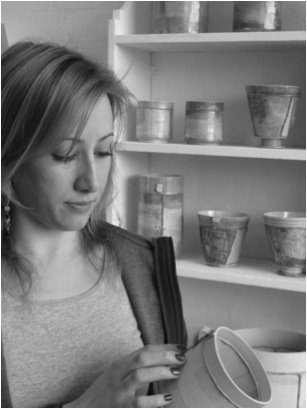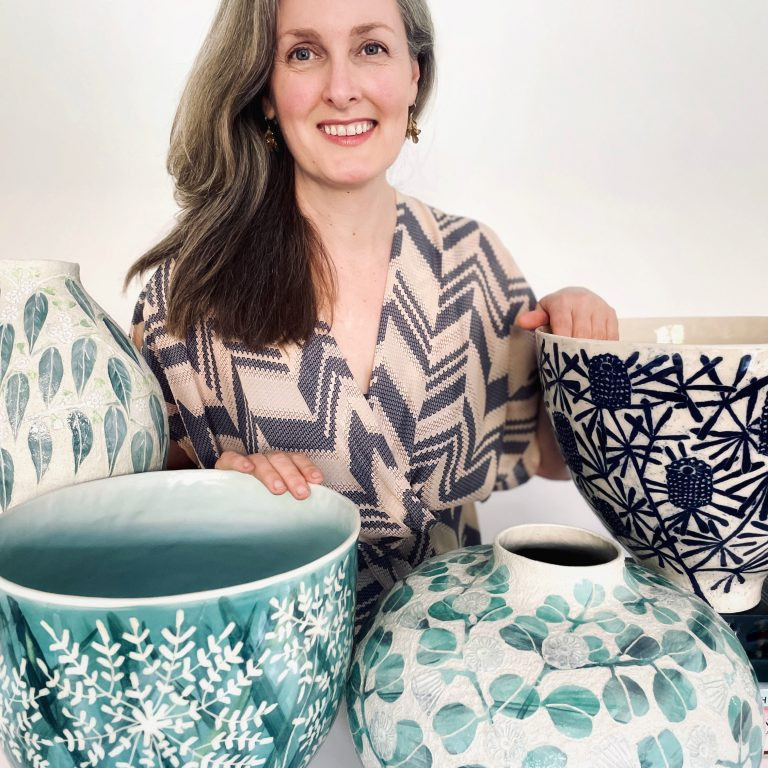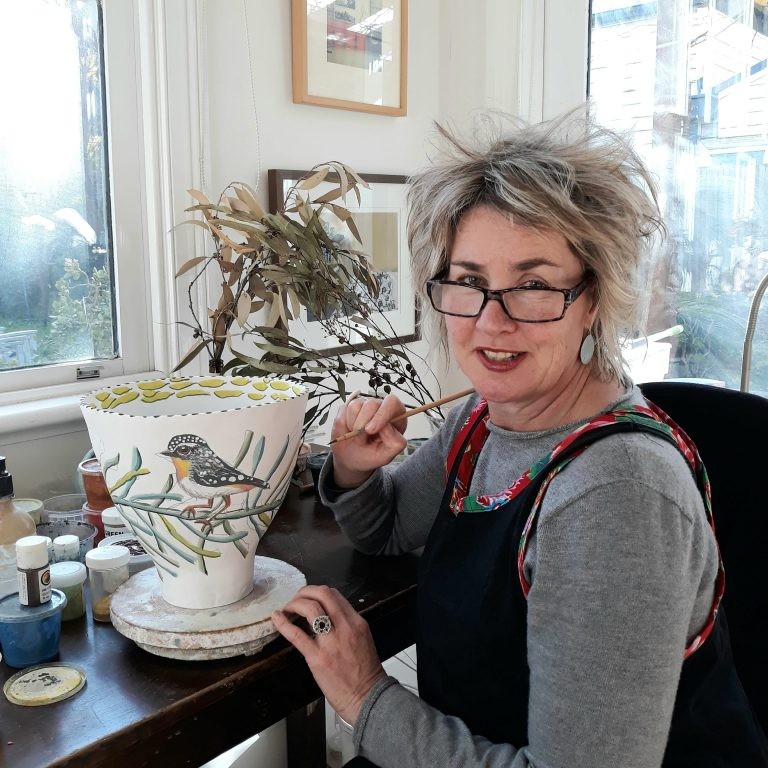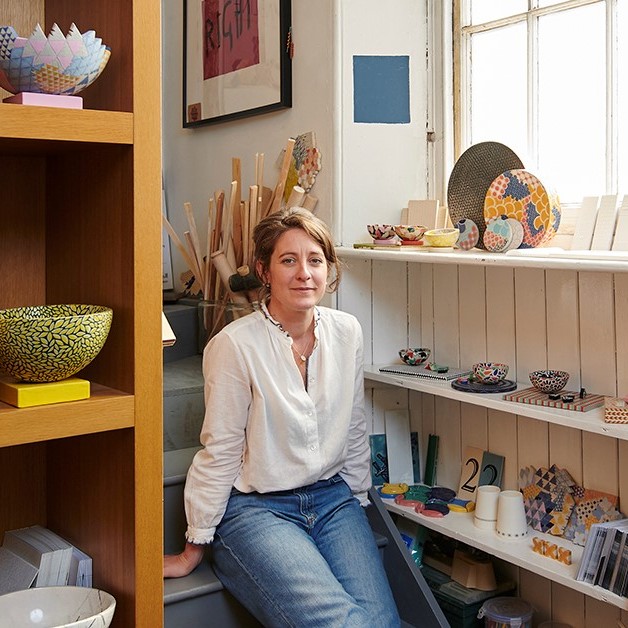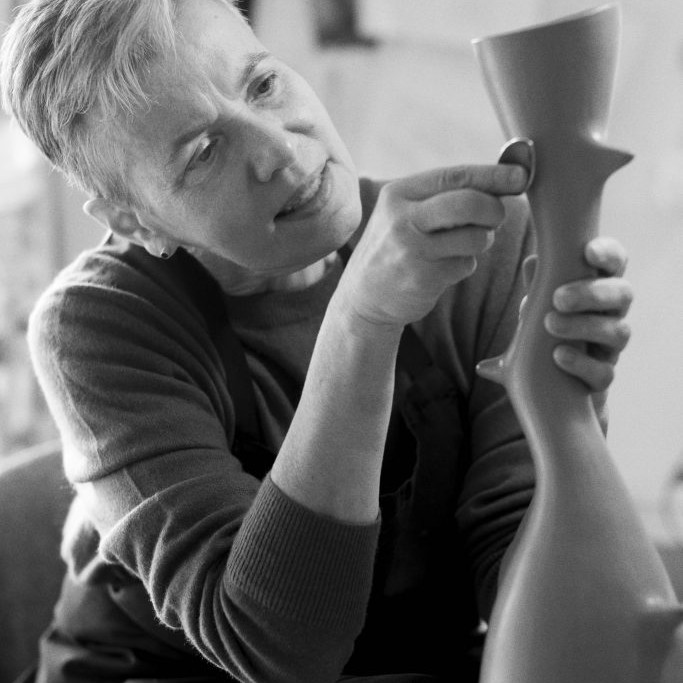Emily-Kriste Wilcox Ceramic Artist - Birmingham, UK
One major emphasis in your work is your subtle colour and design. Can you expand on this?
Painting plays an important role in my process and I make many studies of the sky and landscape which feed into the development of the 3D ceramic work. Firstly, walks are documented with photographs, small paint studies and notes in my sketchbook. Larger paintings further explore and inform colours and textures, which are then developed on into the ceramics. This is an ongoing process, and is a continual source of information for the ceramic work. These elements go hand in hand.
For the ceramics, layers of decorating slips are applied to build up the surface and create a depth that holds similarities to misty skies, or walks across the hills, which in turn allows the pots to create a sense of place – sometimes this can be a memory of a walk or a view across the sea.
Colours are cohesive; often tonal on single pieces and this control over the colour palette enables me to bring each of the differing elements and panels of clay into harmony with each other. Some may have text on, or richer textures/patterns; some are more muted. Some pots make direct references to walks; many are more abstract and open to interpretation. The numerous sky and landscape studies play a large part in this focussing of my colour palette allowing me freedom to then introduce other colours or textures when I’d like to expand on the investigation.
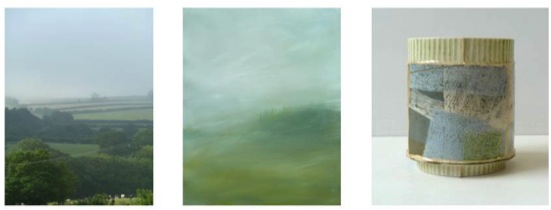
You are currently researching 18th Century tea caddies. Can you explain how this study is directing your work?
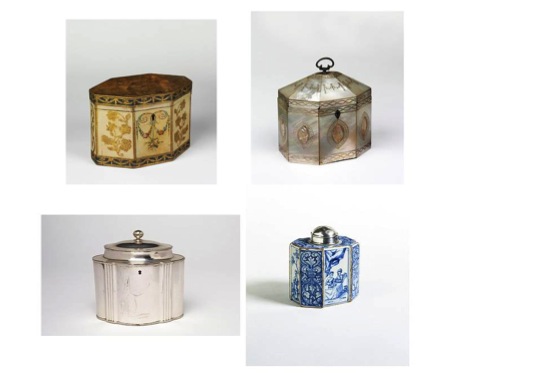
A selection of tea caddies in the V&A collection *(Victoria and Albert Museum, London)
I have been intrigued by the *V&A collection of tea caddies because of the use of faceted panels similar to my own method of construction. Often the straight edged panels were divided or joined by solder or silver yet combined through connected imagery or motifs. There is an added notion that these were highly decorated and intricately worked containers to hold the prized tea; and therefore often displayed for their aesthetic value as well. This all resonated with the way I work, and inspired in part, the oval shaped pieces I have been making in recent years.
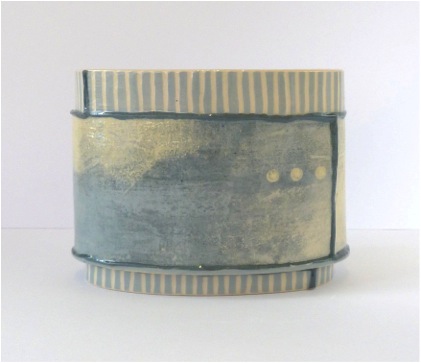
small oval vessel – SO13, H11cm
The final pieces have been worked over with many layers. Can you explain your technique?
Each piece goes through a number of firings to achieve the desired depth of surface. Firstly layers and layers of coloured decorating slips are applied in a painterly manner using brushes and newspaper. This is worked alongside more controlled sgraffito techniques, sometimes in order to ‘contain’ the painted surface, and other times to continue it. This can be seen most predominantly on the rim/foot of my pieces. I also have a collection of hand-carved printing blocks that I use on some pieces. Others have underglazes, transfers or lustres applied.
Each piece is individual and I approach it in this way. I find it is vital to have a conversation with each one, focussing my energy and concentration on one piece at a time. Reflecting and evaluating throughout. I talk to them – do you need a touch more white here, or perhaps a darker section / strip there?
I continue to refer to my 2D paintings and documents of walks to help with this process. Often I know from the offset whether it will be a piece predominantly green or navy blue for example; and can use the painting studies to help achieve the layering of blue/white clouds or whether I’d like to try to capture the splash of white or yellow where the sun hits the water.
Each is an interpretation not a representation. A painting in clay.
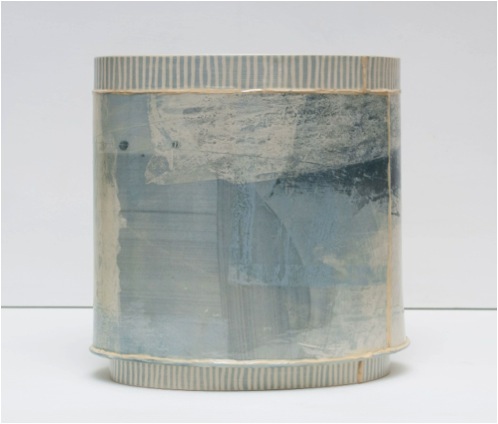
large oval vessel, LO13, H24cm
How long have you been working using this hand-building technique and why this method?
I started with coiling 14 years ago, which is a very versatile way of working. Not restrictive for the forms. To see something build from the bottom up is very satisfying – seeing it ‘grow’ bit by bit & with time to reflect /adapt on the direction of the form as you go.
I still continue to hand-build, perhaps in part for this reason. Hand-building is my specialism, but my work has developed over the years and now I use panels of clay treated to layers of decorating slips to build up a depth of surface. Although the form is very important, with the structures challenging to build; the surface is more of a focus for exploration at the moment. I like to treat each piece of clay like a painting.
I do not make them for an intended ‘function’ other than that of aesthetics. I create pieces that are an interpretation of our surroundings. Many have commented they are a piece of calm and tranquillity for them, which I find very touching.
I love the fine trims you add to your pieces, as well as the grids and narrow bands. Can you discuss this detail of your work?
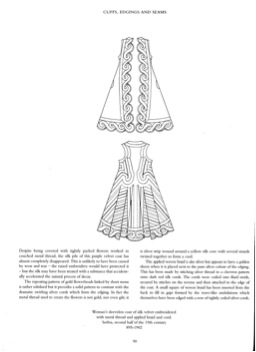
The coloured trims are the joins between each panel of clay. The panels are all treated individually first as flat pieces, then constructed. The join/trim can act as a divider but also as a continuation of the juxtaposed elements within my work. They can also be seen as creating windows onto the view beyond.
There is a lot of historic investigation with regards to my construction techniques and a variety of factors feed in to the multi-faceted pots you see today. Therefore it is difficult to single out one as the starting point – it has been much more of a continuous stream of investigation. However one major reference has been dressmaking patterns which have informed, in part, the goblet and bowl shapes as illustrated.

goblet, g21, H15cm
On several of your pieces you have handwriting, can you elaborate on this? For example, how and when is it added? What does it read? Where do you get the text?
Text is included in some pieces – often to reference a walk, map, dressmaking pattern or poem. I use these in a variety of ways – sometimes as a direct quote from the directions of a walk, a line from a poem; or a strip of an OS map. On others it is more abstracted and I limit the use to initials of place names or the number of miles walked/ distance travelled.
To apply the text, I either use hand carved stamps on leather hard clay, or ceramic transfers after a glaze depending on the piece.
The ‘265 m….’ that is imprinted on SV8 refers to the distance (in miles) from my house in Birmingham to St Ives, Cornwall – one of the places I return to regularly in order to walk and paint.
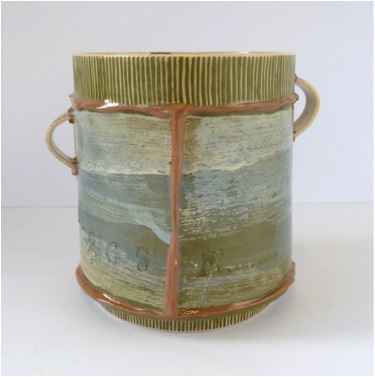
small vessel- SV8, H10cm
Each of your pieces calls to have it twisted to a new angle, giving it a whole new dimension. Can you expand on this?
Yes, the numerous facets make up a panorama, although not always ‘aligned’. With each piece of clay I explore the surface much like the composition of a painting – so all the elements of the 3D are as important as each other. The surface continues in, around, out, under and through.
The inside of your vessels, some have tiny dots – explain the importance of the inside?
The small dots come from maps, dressmaking draft paper and fabrics. Many people have commented they add a contemporary twist. For me, it also adds to the juxtaposition of different elements that inspire me ie sky, landscape ,dressmaking, fabrics, boats; yet in using blue coloured dots this is in keeping with the rest of the tonal variations within the pieces.
The inside is for me just as important as the outside, as I make my vessels as pieces to be explored – some are small enough to be hand held. I use surface decoration not as an afterthought, to be integral to the whole process. Often the inside is treated much softer with thin washes of colour and can be likened to the ocean/sea; with the outside of the pot holding more reference to the sky and the clouds. Some of the directional lines continue in and out – which also continues the conversation you have between the piece and the viewer.
Not only dots on the inside, dots and circles are apparent on most works. Have they become a trade mark?
These have developed in part from my early drawings of maps/boats and buoys on the water, as well as an interest in buttons. Sometimes these dots are directional, ie to follow a map or walk, or the continuation of stitch. Sometimes they represent a row of lights on the horizon. These have been abstracted, drawn from the paintings and sketchbook information, not as representational imagery.
Can you show your makers mark underneath every vessel and tell us how its design came about?
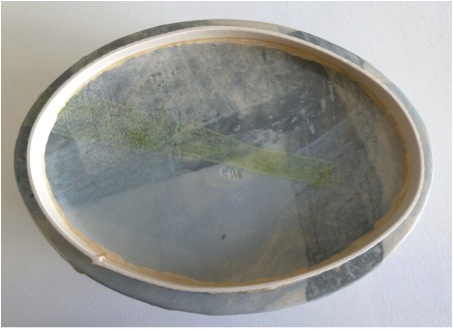
underneath of short oval vessel
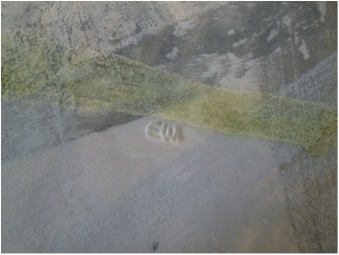
close up of stamp on the base>
The underneath of each vessel is also painted because, for me it is as important as any other panel. The stamp I use is hand carved and a variation on my initials (makers mark reads EWi although for my paintings and for future ceramics it is EKW). I keep it simple so not to distract from the work.
What is the size of your work?
The range evolves in terms of size and scale. I have made tall vessels throughout my professional career. Investigations into the history of the teacup and drinking vessels, including jugs etc, have continued to inform the shapes I make today. Some are handheld (h10cm) and range up to the large oval (h24cm) and the tall large vessel (h34cm). The short oval (h9cm) opens up the inside more to the viewer whereas the goblet / bowls add an extra challenge of balance throughout the construction.
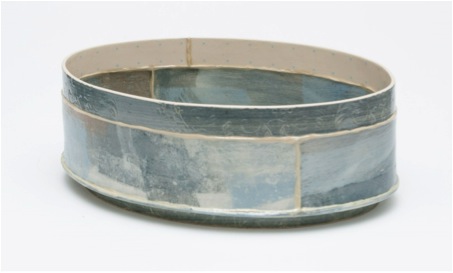
short oval vessel Sh.O2, H9cm
You won the Craft and Design, Silver Award in 2012 (ceramic category). How important have awards been to your career?
Receiving awards for my work always gives me a boost, as it is an amazing recognition. The Craft and Design silver award in 2012 was a public vote which is really special as it means people like it enough to vote for me! I feel supported by that; that the works speak to them.
The recognition of craftsmanship by people in the industry is also invaluable. To know that they value my contribution and my explorations is a huge encouragement to continue.
Your paintings have the same colour and use of your local environment. Can you discuss 2 paintings?
‘Early Morning Mist Study I’ Devon
I watched the mist rise on holiday in Devon and made a series of sketches, notes, photos in my book. I was mesmerised by the misty colours. Within minutes the mist had risen; the sun had hit in one of the fields in the distance highlighting a bright yellow strip. This was in contrast to the colour of the surrounding rolling hills; no buildings in sight for miles. It felt fresh and invigorating, yet peaceful. Early Morning Mist Study 1, is the first of a number of paintings in response to this.
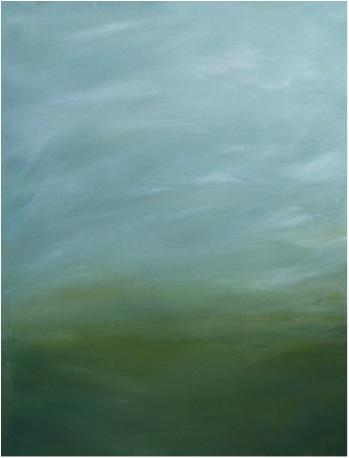
‘Cleeve Hill Cloud Study II’
I have been walking up on Cleeve Hill several times, where the view changes dramatically. I wanted to capture some of that texture and tone as there are lots of different variations of green across Gloucestershire. I am a member of the Gloucestershire Guild of Craftsmen, and have a number of connections in Cheltenham so Cleeve Hill holds a special place in my heart.
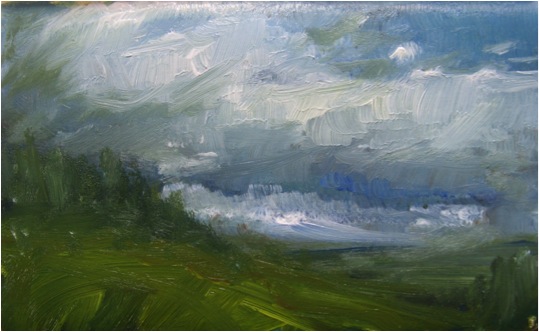
Your environment is infused onto your vessels and paintings. Can you explain the importance of environment to your work?
The environment has become a large part of my process over the years, I find painting helps to explore colour and texture. The ceramic investigations are endless with regards to this, and I love to explore different variations in tone using the raw materials.
Each piece I create is a piece of me; a moment in time, as such each is completely individual. They reflect my own experiences and the environment I walk in, the walks I find vital to keep fresh air in the lungs; for vitality and for invigorating the senses, to clear the head. Getting out of the city to these open spaces is important for me.
There is a newspaper clipping on the wall of my studio which has the headline ‘I couldn’t work without gazing at the sky’
I think that sums me up! Where will it take me next?…….
Contact Details
Emily-Kriste Wilcox,
Studio238, Scott House, Custard Factory, Birmingham, B9 4AA
07763 400 527
Email:mailme@emily-kriste.co.uk
Web: www.emily-kriste.co.uk
Emily-Kriste Wilcox, Birmingham, UK
Interview by Deborah Blakeley, April 2014
Think a colleague or friend could benefit from this interview?
Knowledge is one of the biggest assets in any business. So why not forward this on to your friends and colleagues so they too can start taking advantage of the insightful information the artist has given?
Other artists you may be interested in:


